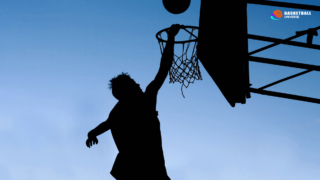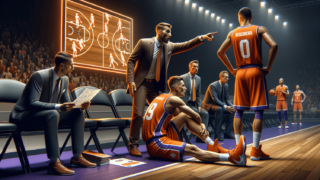
Get ready for a deep dive into one of basketball’s lesser-known strategies: the 3-1-1 Zone Defense! A fascinating mix of deception, coordination, and skill, this defensive scheme challenges even the most seasoned basketball enthusiasts. So lace up your high-tops and let’s explore the intricacies of the 3-1-1 Zone Defense together. Whether you’re a coach looking to add a new arrow to your strategic quiver, or a fan eager to appreciate the nuances of the game, this blog post will leave you feeling like an expert on this truly captivating basketball tactic.
What’s a 3-1-1 Zone Defense in Basketball?
A 3-1-1 Zone Defense in basketball is a strategic defensive formation featuring three players positioned across the top of the key, one player in the middle, and one player near the basket. This defensive scheme aims to pressure the ball handler, disrupt passing lanes, and force low-percentage outside shots. It can be particularly effective against teams with strong perimeter shooting, as it makes it more difficult for shooters to find open opportunities.
Mastering the 3-1-1 Zone Defense: Key Principles
Basketball is a game of strategic offense and formidable defense. To successfully implement the 3-1-1 Zone Defense, understanding its guiding principles is crucial. In this section, we’ll dive into these key principles and explain their role in making this defense an effective option on the court.
Ball Pressure
One of the primary goals of the 3-1-1 Zone Defense is to pressure the ball handler. The three players at the top of the key work together to contain the ball, forcing the ball handler to make quick decisions in the face of relentless pressure. This tactic can lead to turnovers, rushed shots, or a disruption of the opponent’s offensive rhythm.
Disrupting Passing Lanes
The placement of the players in the 3-1-1 Zone Defense allows them to cover an extensive amount of court space, making it difficult for the offense to complete passes. This can result in deflections or interceptions, which may lead to transition opportunities for the defense. By closing off the passing lanes, this zone effectively disrupts the offensive flow and limits scoring opportunities.
Forcing Low-Percentage Shots
The purpose of the 3-1-1 Zone Defense is not only to apply pressure and disrupt passes but also to coerce the offense into taking low-percentage, long-range shots. This defense is especially beneficial against teams reliant on perimeter shooting, as it challenges the shooter’s ability to get an open look. Moreover, the 3-1-1 Zone Defense makes it hard for offenses to attack the rim, ultimately reducing the number of easy baskets and high-percentage scoring opportunities.
Deploying the 3-1-1 Zone Defense: Player Roles and Responsibilities
No defense can truly work effectively without clear roles and responsibilities for each player. Here, we’ll examine what each position entails in the 3-1-1 Zone Defense and how they work in unison to confound opponents.
Top Three Players: Pressuring the Perimeter
In the 3-1-1 Zone Defense, the top three players form a line across the top of the key. These players (usually guards and a forward) are responsible for pressuring the ball handler, closing off passing lanes to the wings, and getting a hand up on any potential long-range shots. Quickness, agility, and communication are essential for the top three players to excel in their roles. They need to make appropriate switches based on the ball handler’s movement, ensuring that the perimeter remains under control at all times.
Middle Player: Patrolling the Free-Throw Line
The middle player, typically a forward, occupies the free-throw line area in the 3-1-1 Zone Defense. This player’s task is to deny entry passes to the high post and close off driving lanes for the offense. Furthermore, the middle player must be prepared to collapse and help defend the paint when necessary.
Effective middle players in the 3-1-1 Zone Defense must possess excellent anticipation, lateral quickness, and communication skills. They act as the central link between the top and bottom defenders, which is crucial for the zone’s success.
Anchor Player: The Last Line of Defense
Positioned near the basket, the anchor player, usually a center, is the last line of defense in the 3-1-1 Zone Defense. Their primary responsibilities include protecting the rim, denying passes into the low post, and securing rebounds after missed shots.
Size, shot-blocking ability, and rebounding prowess are critical attributes of a successful anchor player. However, they should also possess the agility necessary to cover the baseline and help on wing players when the defense is stretched.
Strengths of the 3-1-1 Zone Defense
Now that we’ve grasped the ins and outs of the 3-1-1 Zone Defense, let’s discuss its advantages when properly executed. This defensive scheme can be a game-changer when deployed under the right circumstances.
Disorienting Offensive Rhythm
Offenses thrive on rhythm, and the 3-1-1 Zone Defense aims to throw them off balance. By pressuring the ball handler and disrupting passes, this zone can force the offense into making hasty decisions, ultimately leading to poor shot selection and turnovers.
Controlling the Perimeter
With three players defending the top of the key, the 3-1-1 Zone Defense excels in contesting outside shots, reducing the chances of open looks from beyond the arc. This can be particularly effective against teams that rely heavily on three-point shooting, as it denies their primary scoring option.
Transition Opportunities
When executed correctly, the 3-1-1 Zone Defense can generate turnovers through interceptions and deflections. This creates fast-break opportunities for your team, leading to quick and easy baskets on the other end of the court.
Weaknesses of the 3-1-1 Zone Defense and How to Counter Them
While the 3-1-1 Zone Defense has its advantages, it also presents some weaknesses that opponents might attempt to exploit. Being aware of these vulnerabilities and how to counter them will help you keep your defense strong under pressure.
Vulnerability on the Glass
Zone defenses, in general, can be more susceptible to offensive rebounds. Since players are not directly matched up with their opponents, boxing out and securing rebounds can become more challenging. However, practicing proper rebounding technique, emphasizing communication, and promoting a team effort can help mitigate this weakness.
Exposure to Mid-Range Shots
Teams with strong mid-range shooters might find success against the 3-1-1 Zone Defense. Since the focus is on denying outside shots and protecting the paint, the area around the free-throw line can be vulnerable. To counter this, ensure that the middle player in the zone is prepared to challenge these shots without compromising their position too much.
Overloading One Side of the Court
Competent offenses can disrupt the 3-1-1 Zone Defense by overloading one side of the court. As a result, defensive rotations may become more difficult, and the zone’s integrity could be compromised. The solution to this issue is ensuring that your defenders communicate effectively and adjust their positions fluidly when necessary.
Strategies for Success: Making the 3-1-1 Zone Defense Work for Your Team
Implementing the 3-1-1 Zone Defense successfully requires thoughtful planning, devoted practice, and continuous assessment of its effectiveness. In this section, we’ll provide some valuable strategies to help you make this defensive scheme a cornerstone of your team’s success.
Drill Your Players on Defensive Rotations
Efficient rotations are an essential aspect of the 3-1-1 Zone Defense. Ensure that your players understand their roles and responsibilities within the zone, and conduct regular drills to help reinforce proper positioning and movement. Teach your players to read the offense and anticipate its next move, which will enable them to be in the right position at the right time.
Emphasize Communication
Effective communication is critical to the success of any zone defense. Encourage your players to talk incessantly on the court, calling out screens, switches, and potential offensive moves. The more they communicate, the better they can coordinate their efforts and maintain the integrity of the zone.
Be Adaptable
Monitor how well the 3-1-1 Zone Defense is working during a game, and be prepared to make adjustments if necessary. Whether it’s a minor tweak to player positioning or a complete shift to another defensive scheme, remaining adaptable will help you stay one step ahead of your opponents.
Combine Defensive Schemes
To keep the offense off-balance, consider combining the 3-1-1 Zone Defense with other defensive schemes. You can switch between man-to-man, 2-3 zone, or even a full-court press throughout the game to constantly challenge the opposition and disrupt their rhythm.
Armed with this in-depth knowledge of the 3-1-1 Zone Defense, you’re ready to make an informed decision about whether it’s the right strategy for your basketball team. Understanding the principles, roles, strengths, and weaknesses will empower you to elevate your team’s defensive prowess and potentially lead them to great heights on the court.
Adjustments and Countermeasures: Adapting to the 3-1-1 Zone Defense
Even though the 3-1-1 Zone Defense can be a powerful strategy, skilled offensive teams can still find ways to exploit its weaknesses. In this section, we’ll provide some adjustments and countermeasures that coaches can deploy to break down an opposing 3-1-1 Zone Defense.
Move the Ball Quickly
Quick and precise ball movement is key to breaking down any defense, especially the 3-1-1 Zone. Encourage your players to make sharp, accurate passes, continually looking for open shots and driving lanes. Rapid ball movement will cause the defense to shift, potentially creating gaps that can be exploited by the offense.
Create Space with Screens
Setting screens on the perimeter can create space for your shooters and disrupt the 3-1-1 Zone Defense. This forces the top defenders to either fight through the screen or switch, momentarily breaking down the zone’s cohesion. Utilizing off-ball movement, in conjunction with screens, can generate open looks and force the defense to adapt constantly.
Utilize the High Post
Getting the ball to the high post can be an effective weapon against the 3-1-1 Zone Defense. Position a skilled passer or scorer at the free-throw line, and have them look for opportunities to either drive or dish the ball to cutting teammates. This forces the middle defender to commit to the high post, creating passing lanes and easy scoring opportunities for your team.
Attack the Baseline and Short Corners
The 3-1-1 Zone Defense can be vulnerable along the baseline and within the short corner areas, as the anchor defender is responsible for covering a significant amount of ground. Encourage your players to exploit these areas and force the defense to collapse, subsequently creating open opportunities for outside shots or quick, interior passes.
Integrating the 3-1-1 Zone Defense into Practice: Drills and Tips
Understanding the 3-1-1 Zone Defense and how to utilize it on the court is only part of the equation. The next step is incorporating it into your team’s practice regimen, helping players develop the skills essential for successfully executing this strategy. Here, we offer some drills and tips to ensure your team’s 3-1-1 Zone Defense is sharp, effective, and ready for action.
Shell Drill to Reinforce Positioning
The Shell Drill is a staple in basketball practice, as it helps reinforce defensive positioning and communication. To adapt this drill for the 3-1-1 Zone defense, place defenders in their respective zone positions and have the offense run through planned plays. Focus on the defenders maintaining proper positioning, quickly rotating when necessary, and communicating effectively. You can add variations to the drill to emphasize different aspects of the defense, such as close-outs, rebounding, or switches.
2-on-2 or 3-on-3 Breakdown Drills
Breaking down the 3-1-1 Zone Defense into smaller components will allow players to fully develop their abilities within the zone. Utilize 2-on-2 or 3-on-3 drills that focus on specific aspects of the defense, such as the top three players pressuring the ball handler or denying wing passes, the middle player defending the high post, or the anchor player contesting low post passes and shots.
Zone Scrimmages
Regularly practice your 3-1-1 Zone Defense during full-court scrimmages. This will allow your team to experience the defense in real-game situations, build chemistry, and identify areas of improvement. Adjust the rules of the scrimmage as needed to emphasize specific aspects of the defense, such as forcing the offense to make a certain number of passes or only allowing open shots with less than a few seconds left on the shot clock.
With these additional insights, adjustments, and practice tips, your team will be well-equipped to both execute and counter the 3-1-1 Zone Defense on the basketball court. Remember, practice and communication are key to making your team’s 3-1-1 Zone Defense a powerful and effective weapon during games.
FAQ: All Your 3-1-1 Zone Defense Questions Answered
As you embark on your journey to explore and master the 3-1-1 Zone Defense, you might have some questions that need clarification. To help you navigate this dynamic defensive strategy, we’ve compiled a list of common questions with concise answers to guide you on your quest.
1. In which game situations should a coach consider using the 3-1-1 Zone Defense?
A coach should consider using the 3-1-1 Zone Defense against teams with strong perimeter shooters, when looking to disrupt the opponent’s offensive rhythm, or when the team has to protect a key player from getting into foul trouble. It can also be utilized as a change-up defense to keep the offense guessing.
2. How is the 3-1-1 Zone Defense different from other zone defenses?
The 3-1-1 Zone Defense is distinctive due to its placement of three players at the top of the key to pressure the ball handler, a single player in the middle to deny high post passes, and an anchor player near the basket. This formation emphasizes perimeter control, disrupts passing lanes, and forces low-percentage shots more than many other zone defenses.
3. Can the 3-1-1 Zone Defense be run alongside other defensive strategies?
Absolutely! Coaches can mix and match the 3-1-1 Zone Defense with other schemes, such as man-to-man, 2-3 zone, or various full-court press defenses. Combining defenses during a game can keep the opposition off-balance and maintain strategic unpredictability.
4. What makes an effective middle player in the 3-1-1 Zone Defense?
An effective middle player should possess excellent anticipation, lateral quickness, and communication skills. They act as the central link between the top and bottom defenders, and must be able to deny entry passes to the high post while also closing off driving lanes.
5. Which teams and coaches have famously used the 3-1-1 Zone Defense in basketball history?
While not as widely known as some other defenses, the 3-1-1 Zone Defense has been used sporadically by various teams over the years. It is often tailored to specific situations or opponents as part of a broader strategic plan. Specific examples of teams or coaches that have used this strategy are harder to identify, as this defense can closely resemble others, such as the 1-3-1 Zone Defense, when implemented.
6. How can a team improve their execution of the 3-1-1 Zone Defense during practice?
Teams can improve by focusing on drills that reinforce proper positioning, movement, and communication within the zone, such as the Shell Drill and 2-on-2 or 3-on-3 breakdown drills. Additionally, regularly practicing the 3-1-1 Zone Defense during full-court scrimmages can help build chemistry and expose areas that need improvement.
7. Can the 3-1-1 Zone Defense be used as a full-time defensive strategy?
While the 3-1-1 Zone Defense can be highly effective, relying on it as a full-time defensive strategy may make a team predictable and easier for opponents to counter. Instead, it is best to use it as part of a broader defensive game plan, mixing it with other strategies to keep the opposition guessing.
8. What type of players are most suitable for the 3-1-1 Zone Defense?
Quick, agile players with good communication skills are ideal for the top three positions in the defense. The middle player should have excellent anticipation and the ability to cover the high post, whereas the anchor player should be strong at shot-blocking, rebounding, and protecting the paint.
9. Can superior offenses easily break down the 3-1-1 Zone Defense?
While skilled offensive teams can exploit some of the 3-1-1 Zone Defense’s vulnerabilities, such as offensive rebounds and mid-range shots, the defense can still be highly effective when executed correctly. A well-prepared, adaptable team can counter the offense by making timely adjustments and maintaining solid communication on the court.
10. How does the 3-1-1 Zone Defense affect rebounding opportunities?
Zone defenses, including the 3-1-1, can be more susceptible to offensive rebounds compared to man-to-man defense, as players are not directly matched up against the opposition. To counter
Featured Posts
- No pillar pages found.





